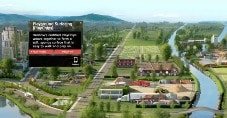Playground Wood Chips – Are they safe?
/0 Comments/in Blower Truck Services, Parks, Playgrounds /by Tanya RichardsPlayground Wood Chips – Are they safe?
Playground wood chips are a way to cushion children if they should fall off of or near playground equipment, making the purpose of these wood chips all about safety. However, anything that will interact with children must be safe and trustworthy. When acquiring engineered wood fibre from a reputable supplier that is carefully produces the material, you can rest assured that the product will be safe.
Allergies
Allergies are always a potential hazard, as with any kind of new material introduced into a child’s life. Properly produced engineered wood fibre specifically for playgrounds are made from clean wood taken from mature forests, which is also called virgin wood. These trees have existed in an environment where there has been little to no interference from humanity, which means that there should be few to any harmful allergens involved. And since children are unlikely to come into any but brief skin contact with the wood chips, the likelihood of an allergic reaction is extremely low.
Compression
Properly produced playground wood chips are designed to be compressed in depth once placed in the playground. Typically, in order to effectively cushion the types of falls that a child would sustain from falling off of playground equipment, wood chips need to be piled to a depth of at least one foot after compression. Since compression is natural, particularly with kids running around on it, every year the the wood chips will tend to compress roughly three inches. If the wood chips become too compressed, they stop being safe because they become too rigid and dense. This is when a top-up is required to maintain the minimum 12″ depth.
General Shape
Wood chips that are designed to be used on playgrounds are not the same kind of wood chips or bark mulch that you would use in landscaping. Engineered wood fibre is made from the wood of the tree, and doesn’t include any bark mulch. With no bark and because of the way the wood is cut, silvers are minimal. If a child tumbles onto wood chips, having a reasonably smooth surface is important to keep from cutting his or her skin or poking them painfully. The cut of the material is designed to be both a cushion and to allow some rolling to occur.
Additional Characteristics
One important characteristic that the right kind of playground wood chips possess is that they are manufactured to be very fibrous. These fibers add to the spring-like qualities of the wood chips, so they will bend and flex if they need to cushion a fall instead of snapping and becoming dangerous. This is different from the high rigidity that most landscaping materials possess, which makes playground wood chips safer for this specific use. Engineered wood fibre is to be produced to meet ASTM standards, and the supplier should have their material tested regularly.
Extra Materials
Properly manufactured playground wood chips do not feature any foreign materials. While the rules for mulch and most other kinds of wood chips are very loose, the standards for playground wood chips are far stricter. For example, there are to be no twigs, no pebbles, and no pieces of bark mixed in with playground mulch. No recycled materials such as pallets or wood waste. Those extra pieces of material can end up being overly rigid and sharp, which can be harmful to a child amid a fall.
Chemical-Free
Chemicals tend to trigger allergies, skin rashes and other types of problems, to say nothing of being harmful to the overall environment. Obviously, pesticides should never be a part of your playground wood chips because these chemicals should never come near children. A lesser-known but hazardous substance called chromated copper arsenate is a major chemical that is used in timber preservation, but treated wood should never be involved in playground wood chips. You can identify the use of this chemical preservative by the green tint it gives wood.
Effective Sourcing
Working with the right supply company is the difference between being highly satisfied with the end results or being disappointed with them. You have responsibility to ensure a safe playground for children, and safety on the playground is of the utmost importance. Work with a trustworthy company that will only provide the safest hardwood-based playground wood chips. To understand how the best wood chip supply companies operate, you can start by learning more about Denbow, one of the premier wood chip suppliers in British Columbia.
Structural Soil for Urban Trees
/0 Comments/in Green Infrastructure, Landscape, Soil, Sustainable Development /by Tanya RichardsStructural Soil for Urban Trees
Currently most urban trees are planted directly into existing compacted urban soil or tree pits with limited root space. Trees that are planted in areas surrounded by paving tend to struggle for air space and usually decline well before they should. Where soil volume is limited by pavement, tree roots suffer and tend to take the path of least resistance searching for air, usually in and around pipes, foundations, or to the surface. Healthy trees need a large volume of non-compacted soil with adequate drainage and aeration and reasonable fertility.
While the need and desire for large trees in the urban landscape still is the desired intent, the trees do not survive long enough to fill the need. Not planning for root growth is ignoring the biological requirements of trees and is not economical or environmentally prudent. The failure to provide adequate soil for both drainage and root growth is critical to the life of the tree and without an engineered soil specific to this application, trees have a shortened life span and may die. Ensuring a good supply of air to the tree roots is essential for satisfactory tree growth, however in urban situations, the movement of air into the soil is often restricted. By providing additional root space below the pavement in what otherwise was compacted urban soil, Structural Soil can allow most newly planted trees to have a chance for healthy growth. This mix consists of 80% 75 mm angular clear aggregate and 20% approved sandy clay loam. The aggregates bear the load, providing the structural stability for the pavement above. The angularity of the rock create for the non-compacted soil, providing space for air, water and nutrients the roots, as well as provide for future root expansion. Engineered structural soil provides a resource for root growth beyond the traditional tree pit, allowing for much stronger root growth and ongoing tree health. 
Denbow has been providing structural soil to many municipalities within the Greater Vancouver and Fraser Valley area. These departments use Denbow’s manufactured soil to allow city planners and engineering departments to add trees for the health and beauty of urban communities.
Contact Denbow’s soil experts today to find out more about how structural soil can work in your city or municipality.
Save
Save
9 Benefits to Using Compost for Erosion and Sediment Control
/0 Comments/in Environment, Erosion Control, Municipal and Infrastructure Journal, Sediment Control, Slope Stabilization, Stormwater Management, Sustainable Development /by Tanya RichardsWhat is Structural Soil and Why is it Good for Trees
/0 Comments/in Construction Landscape Journal, Corporate News, Green Infrastructure, Landscape, Municipal and Infrastructure Journal, Soil /by Tanya RichardsWhat is Structural Soil Why is it good for Trees?
Why is structural soil effective?
Structural soil is a type of soil mixed with a specific type of gap-upgraded rock (typically 75mm clear). This is a very important part of the specification; the reason structural soil works well is that the gaps created by the rock are then filled with soil, enabling penetration by tree roots. This penetration allows the tree access to a larger space underground, and has the double function of preventing the tree roots from lifting up the hard surface, i.e. the sidewalk that is on top.
How does the structural soil get tested?
The testing of structural soil is essentially a three-part process. The soil must be tested separately. The rock must be tested and sourced with a specific sieve size attached to it to determine that it is in fact a clear rock and not a minus rock. With a minus rock all of which would be filled and therefore the soil would be effective.
There is also a stabilizing compound that is used with structural support to help the soil adhere to the rock. The specifications for this material would come directly from the stabilizer supplier; there are more than one of these.
Who can make structural soil?
Like any engineered soil, structured soil is a technical process which is best done by people who understand all the specific components and have all the components readily available with testing and prior knowledge. Making good structural soil to specification is an extremely important endeavour. Structural swell that is not up to specification is a very difficult situation to remediate once it’s already in the ground.
If you enjoyed this edition of “Ask Tom” please share with your friends!

Dealing with the Chafer Beetle – Nematode Protocol Update
/in Corporate News, Landscape, Landscape Journal, Parks, Seeding, Summer Landscape Ideas /by Tanya RichardsDealing with the Chafer Beetle – Nematode Protocol Update
Two options for addressing chafer beetle infestations
Are you or your clients having problems with the European Chafer beetle destroying lawn? We suggest the protocols described below. Please keep in mind that the insecticide must be administered by a professional with a pesticide applicator’s certificate. The rest could be done by a homeowner, but it is a procedure that is far more likely to be done by a landscaper.
The first option is to do an Imidacloprid drench. After the drench, wait a few weeks, then remove the turf and as much soil as is reasonable—a minimum depth of 2 inches. Next, add soil to required depth; the soil can either be Terraseeded, hand seeded, or lay sod. Make sure to do this in late July/early August before applying the nematodes.
By removing the turf and some soil, you’re taking out most of the grubs, even the ones killed by the Imidacloprid. The large grubs are more difficult for the nematodes to kill. Applying nematodes after egg-hatch (in mid-late July) will target the small grubs, which is more effective. It should be emphasized that nematodes should be applied annually if the Chafer Beetle continue to be a problem in their area.
There is the issue that not all jurisdictions allow the application of this insecticide. Therefore, each customer must find out what is acceptable within their jobsite and municipality.
If insecticide use is not permitted in the area, there is a second option. First, apply the nematodes at recommended rates to the soil in April through June, and then again in September through early November; the nematodes should be applied in areas of known infestation where specific lawns show signs of chafer infestation. Remember that the lawns must remain damp for at least two weeks after nematode applications.
For both options, it is very important to follow healthy lawn practices as well established lawns are more resistant to chafer damage. These practices include aeration and topdressing, watering well at appropriate intervals, consistent fertilization, and cutting to a 2-inch height (not too short).

Remediation
In order to resist the chafer beetle when projects are newly installed, consider the following recommendations. First, if permissible, drench the soil with Imidaclorprid. Then, excavate and dispose of native topsoil to a reasonable depth of 2-6 inches. Replace the excavated material with compost-based soil; the type of soil should be based on specific requirements, i.e. turf. If applicable for the application, the use of grass species such as tall fescues and alternatives such as Microclover will help resist the beetle. Overseed the remediated areas at 3-4 times the suggested rates; in theory, this makes it difficult for the chafer to get to the surface. It will also make it harder for the chafer predators (birds, raccoons, etc.) to do damage. Lastly, encourage the use of any product or method that will increase turf establishment as well-rooted turf will stand a better chance.
Overall, it is important to remember that the European chafer beetle is an ongoing problem that is unlikely to be solved easily. There is no silver bullet. Providing quality products and installation combined with a willingness to maintain the remediated areas will improve the customers chance of a successful project.
Check out our full infographic on “How to Deal with the Chafer Beetle”. Enjoy and please share!
Here are some other resources we have found online that may be of help:
https://www.burncolandscape.com/chafer-beetles-lower-mainland/
http://www.cuttingedgevancouver.com/services/chafer-beetle-control/
http://www.landscapingvancouver.ca/chafer_beetle_vancouver.html
http://www.artknapps.ca/preventions-and-treatments-of-chafer-beetle/
http://www.coquitlam.ca/city-services/environment/european-chafer-beetle.aspx
Save
Save
Soil Series – Who is this Tom?
/0 Comments/in Green Infrastructure, Landscape, Municipal and Infrastructure Journal, Soil /by Tanya RichardsSoil Series – Who is this Tom? segment #2023
“Dirt is the stuff underneath your fingernails, whereas soil is an engineered composition of organic matter (sand, clay and organic matter) designed specifically for your project’s grow media and geographic location.”
– Tom McConkey
So who is this Tom McConkey?
Before we start talking about “soil”, we want to introduce our specialist. Denbow is pleased to be offering this series of interviews with one of our valued partners, Tom McConkey. Tom is highly skilled in landscape and our local soil and has been in the field for over two decades. Some of his specialty areas include Green Roofs, Urban Agriculture, Bio-Swales, Storm Water Management, Sustainable Turf Grass Practices.
Tom attended Carelton University and earned a degree to become an English teacher but as fate would have it, Tom decided to take a position at a local landscape company instead.
Early on there he got involved in the company’s compost practices. Tom became very interested in not only selling the compost, but understanding the composting process.
At the time, composting was a new aspect of the landscape industry so Tom was given the freedom to get to really “dig in,” so to speak.
During his early years, Tom was able cultivate his knowledge and skills while being mentored by Dr. Bill Herman of Pacific Soil Analysis. Dr. Herman is a soil specialist who instructed Tom in both the composting process and more importantly, the beneficial use of organic matter as it pertains to the British Columbia Lower Mainland network.
Denbow hopes this interview series with expert, Tom McConkey serves Landscape architects, city managers and landscapers as well as the average joe gardener in understanding the complexity of engineered soil and how it can assist their projects.
Newton Pond – Revegetation Project
/0 Comments/in Municipal and Infrastructure Journal, Parks, Projects, Stormwater Management /by Tanya RichardsStructural Soil: An Innovative Medium Under Pavement
/0 Comments/in Green Infrastructure, Soil /by Tanya RichardsStructural Soil An Innovative Medium Under Pavement
Have you ever wondered how on earth trees grow in little square planters alongside roadways and sidewalks?
Unless you are one of the few in the know, you probably have. An education on structural soil help will help explain how growing trees below pavement is possible and how it provides urban areas opportunity to enhance the green space within city limits.
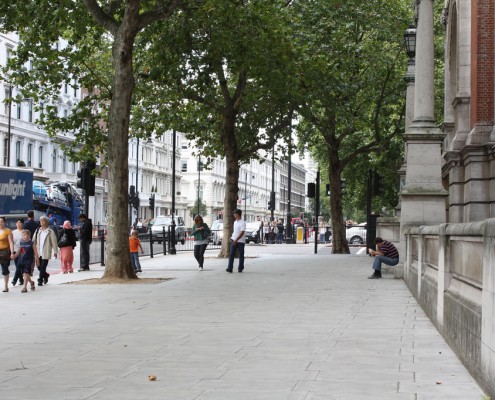 Here’s a great article from Cornell University that helps highlight the composition and uses of structural soil. There is a ton of valuable and informative information here, we hope you enjoy it as much as we did.
Here’s a great article from Cornell University that helps highlight the composition and uses of structural soil. There is a ton of valuable and informative information here, we hope you enjoy it as much as we did.
Read the full article here.
Introduction
The major impediment to establishing trees in paved urban areas is the lack of an adequate volume of soil for tree root growth. Soils under pavements are highly compacted to meet load-bearing requirements and engineering standards. This often stops roots from growing, causing them to be contained within a very small useable volume of soil without adequate water, nutrients or oxygen. Subsequently, urban trees with most of their roots under pavement grow poorly and die prematurely. It is estimated that an urban tree in this type of setting lives for an average of only 7-10 years, where we could expect 50 or more years with better soil conditions. Those trees that do survive within such pavement designs often interfere with pavement integrity. Older established trees may cause pavement failure when roots grow directly below the pavement and expand with age. Displacement of pavement can create a tripping hazard. As a result, the potential for legal liability compounds expenses associated with pavement structural repairs. Moreover, pavement repairs which can significantly damage tree roots often result in tree decline and death.
The problems as outlined above do not necessarily lie with the tree installation but with the material below the pavement in which the tree is expected to grow. New techniques for meeting the often opposing needs of the tree and engineering standards are needed. One new tool for urban tree establishment is the redesign of the entire pavement profile to meet the load-bearing requirement for structurally sound pavement installation while encouraging deep root growth away from the pavement surface. The new pavement substrate, called ‘structural soil’, has been developed and tested so that it can be compacted to meet engineering requirements for paved surfaces, yet possess qualities that allow roots to grow freely, under and away from the pavement, thereby reducing sidewalk heaving from tree roots.
Convential Tree Pits are Designed for Failure Looking at a typical street tree pit detail, it is evident that it disrupts the layered pavement system. In a sidewalk pavement profile, a properly compacted subgrade of existing material often is largely impermeable to root growth and water infiltration and significantly reduces drainage if large percentages of sand are not present. Above the subgrade there is usually a structural granular base material. To maintain a stable pavement surface the base material is well compacted and possesses high bearing strength. This is why a gravel or sand material containing little silt or clay is usually specified and compacted to 95% Proctor density (AASHTO T-99). The base layer is granular material with no appreciable plant available moisture or nutrient holding capacity. Subsequently, the pavement surrounding the tree pit is designed to repel or move water away, not hold it, since water just below the pavement can cause pavement failure. Acknowledging that; the above generalizations do not account for all of the challenges below the pavement for trees, it is no mystery why trees are often doomed to failure before they are even planted.
The subgrade and granular base course materials are usually compacted to levels associated with root impedance. Given the poor drainage below the base course, the tree often experiences a largely saturated planting soil. Designed tree pit drainage can relieve soil saturation, but does nothing to relieve the physical impedance of the material below the pavement which physically stops root growth.
A New System to Integrate Trees and Pavement
‘Structural soil’ is a designed medium which can meet or exceed pavement design and installation requirements while remaining root penetrable and supportive of tree growth. Cornell’s Urban Horticulture Institute, has been testing a series of materials over the past five years focused on characterizing their engineering as well as horticultural properties. The materials tested are gap-graded gravels which are made up of crushed stone, clay loam, and a hydrogel stabilizing agent. The materials can be compacted to meet all relevant pavement design requirements yet allow for sustainable root growth. The new system essentially forms a rigid, load-bearing stone lattice and partially fills the lattice voids with soil (Figure 1). Structural soil provides a continuous base course under pavements while providing a material for tree root growth. This shifts designing away from individual tree pits to an integrated, root penetrable, high strength pavement system.
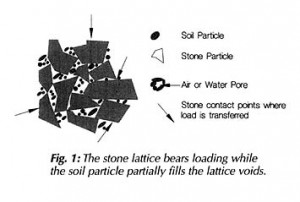
This system consists of a four to six inch rigid pavement surface, with a pavement opening large enough to accommodate a forty year or older tree (Figure 2) .
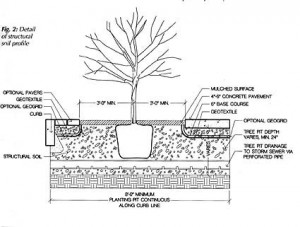
The opening could also consist of concentric rings of interlocking pavers designed for removal as the buttress roots meet them. Below that, a conventional base course could be installed and compacted with the material meeting normal regional pavement specifications for the traffic they are expected to experience. The base course would act as a root exclusion zone from the pavement surface. Although field tests show that tree roots naturally tend to grow away from the pavement surface in structural soil. A geotextile could segregate the base course of the pavement from the structural soil. The gap-graded, structural soil material has been shown to allow root penetration when compacted. This material would be compacted to not less than 95% Proctor density (AASHTO T-99) and possess a California Bearing Ratio greater than 40 [Grabosky and Bassuk 1995,1996]. The structural soil thickness would depend on the designed depth to subgrade or to a preferred depth of 36 inches. This depth of excavation is negotiable, but a 24 inch minimum is encouraged for the rooting zone. The subgrade should be excavated to parallel the finished grade. Under-drainage conforming to approved engineering standards for a given region must be provided beneath the structural soil material.
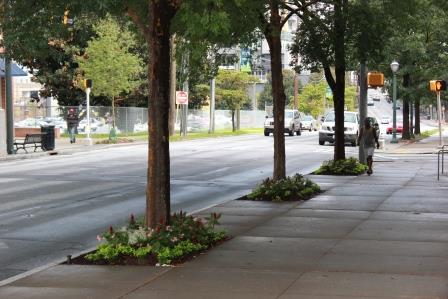 The structural soil material is designed as follows. The three components of the structural soil are mixed in the following proportions by weight, crushed stone: 100; clay loam: 20; hydrogel: 0.03. Total moisture at mixing should be 10% (AASHTO T-99 optimum moisture).
The structural soil material is designed as follows. The three components of the structural soil are mixed in the following proportions by weight, crushed stone: 100; clay loam: 20; hydrogel: 0.03. Total moisture at mixing should be 10% (AASHTO T-99 optimum moisture).
Crushed stone (granite or limestone) should be narrowly graded from 3/4 -1 1/2 inch, highly angular with no fines. The clay loam should conform to the USDA soil classification system (gravel <5%, sand 25-30%, silt 20-40%, clay 25-40%). Organic matter should range between 2% and 5%. The hydrogel, a potassium propenoate-propenamide copolymer is added in a small amount to act as a tackifier, preventing separation of the stone and soil during mixing and installation. Mixing can be done on a paved surface using front end loaders. Typically the stone is spread in a layer, the dry hydrogel is spread evenly on top and the screened moist loam is the top layer. The entire pile is turned and mixed until a uniform blend is produced. The structural soil is then installed and compacted in 6 inch lifts.
In a street tree installation of such a structural soil, the potential rooting zone could extend from building face to curb, running the entire length of the street. This would ensure an adequate volume of soil to meet the long term needs of the tree. Where this entire excavation is not feasible, a trench, running continuous and parallel to the curb, eight feet wide and three feet deep would be minimally adequate for continuous street tree planting.
There will be a need to ensure moisture recharge and free gas exchange throughout the root zone. The challenge may be met by the installation of a three dimensional geo-composite (a geo-grid wrapped in textile one inch thick by eight inches wide) which could be laid above the structural soil as spokes radiating from the trunk flair opening. This is currently in the testing stage. Other pervious surface treatments could also provide additional moisture recharge, as could traditional irrigation.
When compared to existing practice, additional drainage systems, and the redesigned structural soil layer represent additional costs to a project. The addition of the proposed structural soil necessitates deeper excavation of the site which also may be costly. In some regions this excavation is a matter of standard practice. However, this process might best be suited for new construction and infrastructure replacement or repair, since the cost of deep excavation is already incurred.
The Urban Horticulture Institute continues to work on refining the specification for producing a structural soil material to make the system cost effective. It is patent pending and will be sold with the trademark ‘CU-Soil’ to insure quality control. Testing over five years has demonstrated that stabilized, gap-graded structural soil materials can meet this need while allowing rapid root penetration. Several working installations have been completed in lthaca, NY, New York City, NY, Cincinnati, OH, Cambridge, MA and elsewhere. To date, the focus has been on the use of these mixes to greatly expand the potential rooting volume under pavement. It appears that an added advantage of using a structural soil is its ability to allow roots to grow away from the pavement surface, thus reducing the potential for sidewalk heaving as well as providing for healthier, long-lived trees.
by
Nina Bassuk, Director and Professor Urban Horticulture Institute, Cornell University, lthaca, NY
Jason Grabosky, Urban Horticulture Institute, Cornell University, lthaca, NY
Peter Trowbridge, FASLA, Professor Landscape Architecture, Cornell University, lthaca, NY
James Urban, FASLA, James Urban and Associates, Annapolis, MD
Save

